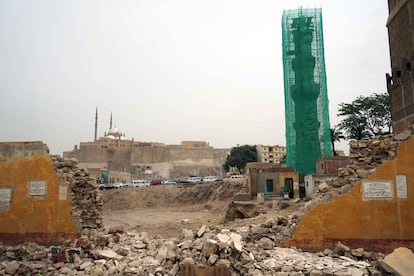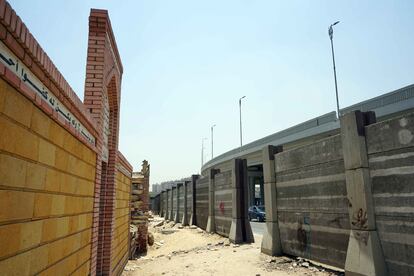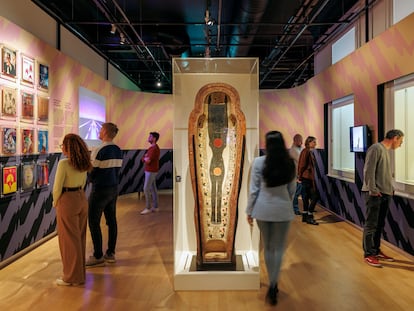Asphalt fever threatens Cairo’s City of the Dead
The 7th-century cemeteries in the east of the capital, of great artistic, architectural and historical value, are being swept aside to make way for roads

The plain that spreads out from the foot of the Mokattam Hills in the southeast of Cairo has served as an important burial place since the arrival of the Muslim Arab conquerors in Egypt in the 7th century. Among the first prominent figures believed to be laid to rest there was, in fact, the commander who led that military campaign, Amr ibn al-As, who ended up serving as the country’s governor.
Since then, successive Egyptian rulers have expanded the necropolis into a vast network of cemeteries, otherwise known as the City of the Dead, consisting of the southern and northern cemeteries which together stretch across approximately 12 kilometers (7.5 miles), covering an area of about 1,000 hectares.
Now, however, a significant portion of this historic site is being reduced to rubble by an aggressive government road construction scheme. Although few details have been released, critics believe that the plans are ruining the city’s urban fabric, and are concerned that hundreds of Islamic architectural treasures are being demolished along with funerary art.
Within the labyrinthine interior of the necropolis stand countless tombs and mausoleums, some of great artistic and architectural value, containing distinguished figures from the country’s past, including former royalty, as well as politicians, poets, scholars, writers, military and senior state officials. In 1979, some of these cemeteries were designated a UNESCO World Heritage Site.
Thousands of lower-class families also occupy the cemetery grounds, many of them having done so for generations and, despite the lack of infrastructure, they have been absorbed quite organically into this peculiar urban space where it is not always easy to tell where a home ends and a small mausoleum begins.

“It’s a tremendous loss of a 1,400-year-old historical heritage,” says Galila El Kadi, an architect, author of Architecture for the Dead: Cairo’s Medieval Necropolis and head of research at the Research Institute for Sustainable Development in Paris. “It is a loss regarding the tombs of those buried there; a loss regarding the memory of these places and regarding the safety [of the dead] in their last place of rest and peace.”
The Egyptian authorities’ goals include easing the traffic in Cairo and facilitating mobility. But skeptics believe these plans are often counterproductive and benefit only a minority. They also warn that they are being implemented in haste, without any public debate, and will alter the identity of many areas of the capital.
The alarm first went off for Cairo’s heritage lovers in 2020 when the construction of two road networks caused the first notable changes to the cemeteries, especially in the Mamluk necropolis. “The area affected by the demolition work there is 100 hectares, which represents 1% of the total of all the necropolises, and which is more than twice the size of the Père-Lachaise cemetery in Paris,” says El Kadi.
The demolition work was, however, apparently put on hold after sparking a considerable outcry on social networks and in the local media, with UNESCO also expressing its concern. But that hiatus was interrupted a month ago and the bulldozers are back in action, concentrating on two major cemeteries south of Cairo.
“The governor of Cairo announced before the last demolition work in May 2023 that 2,500 graves would be demolished,” El Kadi notes. “But we cannot, in fact, know the exact number, because that would require a study in the governorate archives which is not possible in the current context.”

As the authorities’ plans have not been made public, the criteria for demolition work is also unclear. It seems that some of the most emblematic tombs will not be demolished, but among those that have already been razed during this latest campaign include that of the first speaker of the Egyptian Parliament between 1902 and 1909, Abdel Hamid Basha Saddiq, and one of the country’s most celebrated calligraphers, Abdullah Afandi Zohdi, according to a civil society campaign.
“We don’t have the details of what they want to do,” says Mostafa Elsadek, one of the leading members of the initiative calling for safeguarding Cairo’s historic cemeteries. “They haven’t given them to us, so we don’t have an exact idea. We know they are not going to get rid of the historical monuments, but if there is a tomb that is very artistic and more than 150 years old and it is not [legally] considered a historical monument, it’s a problem.”
El Kadi is also concerned that if the monuments that remain standing do so in isolation, they will be adversely affected. “Registered monuments are at risk from air pollution, vibrations from traffic and any change to their environment, such as being surrounded by a network of highways and roads,” he says.
The new demolition campaign has reactivated the voices of Cairo’s group of architects, historians and heritage enthusiasts, formed in late 2021 to document the tombs at risk and claim the importance of preserving them. An online petition has already collected more than 5,000 signatures, and the controversy is being talked about on social networks and the country’s most popular television programs.

This group has gone so far as to draw up alternative plans to the government’s road project to avoid demolition. But Elsadek says their plans have never been considered. Faced with the authorities’ refusal to engage on the issue, many families living in the areas affected have simply accepted offers from the state to move to other homes.
“We raised an alternative initially because they hadn’t demolished anything yet,” says Elsadek. “But now they are demolishing quite a lot. We are not in a position to tell them that there are alternatives because they have already started the work.” In a final bid to try to stop the demolition, the judicial route is being explored. At the end of May, the Egyptian Center for Economic and Social Rights (ECESR) filed an administrative complaint against the authorities responsible for the necropolises, including the prime minister and the governor of Cairo, demanding that they stop the demolition and protect the heritage.
“This is our last chance,” explains prominent human rights lawyer Malek Adly, director of ECESR. “We are really worried because the assault on this area has intensified. We realized that all earlier attempts, claims and complaints had failed, so we had no other option but the courts.”
In mid-June, in response to the criticism, Egyptian President Abdelfattah Al Sisi urged the relevant authorities to build a new cemetery that will house the remains of “the icons of Egypt” that are now located in the City of the Dead. Its site and the criteria for selecting which tombs are to be moved are yet to be decided, although it is thought the cemetery will most likely be built outside Cairo.
Sign up for our weekly newsletter to get more English-language news coverage from EL PAÍS USA Edition
Tu suscripción se está usando en otro dispositivo
¿Quieres añadir otro usuario a tu suscripción?
Si continúas leyendo en este dispositivo, no se podrá leer en el otro.
FlechaTu suscripción se está usando en otro dispositivo y solo puedes acceder a EL PAÍS desde un dispositivo a la vez.
Si quieres compartir tu cuenta, cambia tu suscripción a la modalidad Premium, así podrás añadir otro usuario. Cada uno accederá con su propia cuenta de email, lo que os permitirá personalizar vuestra experiencia en EL PAÍS.
¿Tienes una suscripción de empresa? Accede aquí para contratar más cuentas.
En el caso de no saber quién está usando tu cuenta, te recomendamos cambiar tu contraseña aquí.
Si decides continuar compartiendo tu cuenta, este mensaje se mostrará en tu dispositivo y en el de la otra persona que está usando tu cuenta de forma indefinida, afectando a tu experiencia de lectura. Puedes consultar aquí los términos y condiciones de la suscripción digital.
More information
Archived In
Últimas noticias
Maduro pleads not guilty before the federal court in New York: ‘I am still the president of Venezuela’
A new test can detect Alzheimer’s from a finger prick
UN team enters Sudanese city of El Fasher after paramilitary massacre: ‘It’s like a ghost town’
A recipe for resistance: Indigenous peoples politicize their struggles from the kitchen
Most viewed
- Gilles Lipovetsky: ‘If you want to live better and fall in love, take Prozac, don’t look to philosophy’
- Alain Aspect, Nobel laureate in physics: ‘Einstein was so smart that he would have had to recognize quantum entanglement’
- Alvin Hellerstein, a 92-year-old judge appointed by Bill Clinton, to preside over Maduro’s trial in New York
- Why oil has been at the center of Venezuela-US conflicts for decades
- Maduro’s downfall puts China’s relationship with Venezuela to the test











































